Hops in Beer Brewing: Perle
Published: July 27, 2025 at 10:46:37 PM UTC
Craft brewers often look for versatile ingredients to craft a wide array of beer styles. Perle Hops stand out due to their balanced characteristics and moderate alpha acid content. Perle Hops have been a cornerstone in brewing for their pleasant flavor profile. They are ideal for a variety of beer styles, from pale ales to lagers. Grasping the role of these hops in beer brewing is vital for both novice and seasoned brewers.
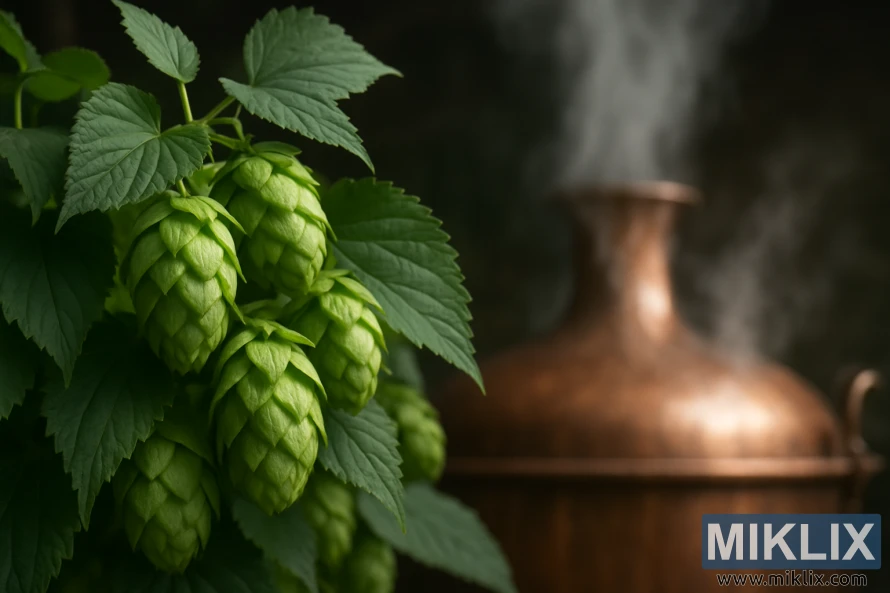
Key Takeaways
- Perle Hops offer a balanced flavor profile suitable for various beer styles.
- Their moderate alpha acid content makes them versatile for different brewing needs.
- Understanding Perle Hops is essential for both new and experienced craft brewers.
- Perle Hops can be used in a variety of beer styles, including pale ales and lagers.
- Craft brewers benefit from the consistent quality of Perle Hops.
Introduction to Perle Hops
In the early 1970s, the Hop Research Institute in Hüll, Germany, successfully bred Perle hops. This variety was developed as part of a breeding program aimed at creating a disease-resistant alternative to Hallertauer Mittelfrüh, a traditional German hop variety.
Perle hops are the result of crossing a Northern Brewer female with an undisclosed German male, contributing to their unique characteristics among hop varieties. As a significant beer ingredient, Perle hops have become valued for their contributions to brewing.
- Originating from a renowned breeding program
- Known for their disease resistance
- Used as a versatile ingredient in various beer recipes
Understanding Perle hops and their history can provide brewers with insights into their applications and benefits in beer production. As a beer ingredient, Perle hops offer a unique profile that can enhance the quality and character of brews.
The History Behind Perle Hops
The origins of Perle hops trace back to the Hop Research Institute in Hüll, Germany. This institute has been leading in hop breeding. They focus on creating varieties that are not just flavorful but also resistant to diseases.
The development of Perle hops showcases the institute's commitment to hop cultivation improvement. Through cross-breeding, researchers aimed to craft a hop with balanced flavor and aroma. This makes it perfect for brewing.
Perle hops were designed to be versatile, fitting various beer styles. Their creation involved rigorous selection and testing. This ensured they met the brewing industry's high standards.
The key characteristics of Perle hops include:
- Disease resistance, making them easier to cultivate
- Balanced alpha and beta acid content, contributing to their versatility
- A distinct aroma profile that enhances the brewing process
The Hop Research Institute's efforts on Perle hops have significantly influenced craft beer history. They offer brewers a reliable and high-quality hop variety.
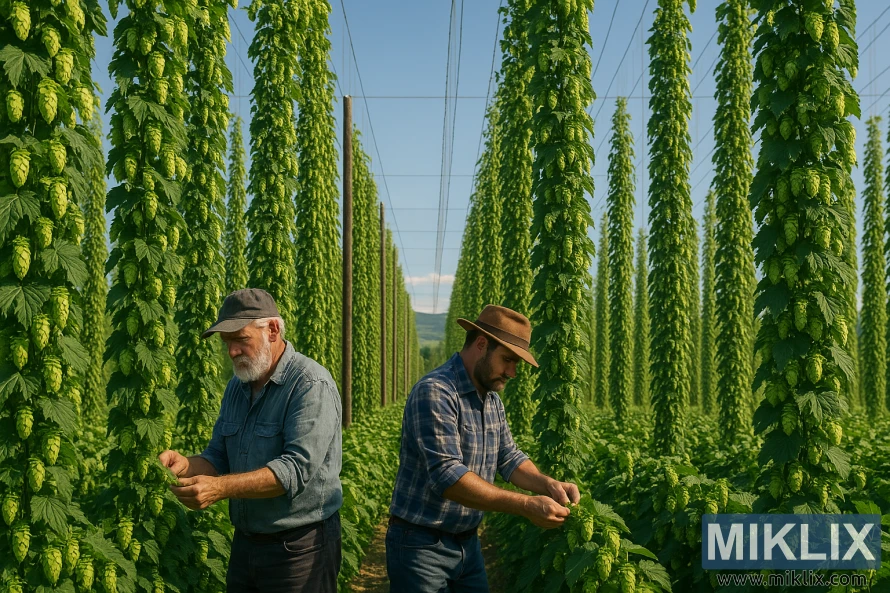
Chemical Composition and Aroma Profile
For brewers aiming to enhance their beer's flavor and aroma, grasping the chemical makeup of Perle hops is key. These hops boast a moderate alpha acid content, typically between 7-9%. This range allows them to serve both as bittering agents and contributors to the beer's aroma.
The chemical structure of Perle hops is a mix of alpha acids and essential oils. These components are vital for the hop's impact on beer's taste and smell. Alpha acids are responsible for bitterness, while essential oils define the hop's aroma.
Perle hops are known for their subtle aroma, which combines floral, spicy, and herbal notes. This unique scent makes them a favorite among brewers. They seek to add depth and complexity to their brews without dominating other flavors.
- Moderate alpha acid content (7-9%) for balanced bitterness
- Essential oils that contribute to a floral, spicy, and herbal aroma profile
- Versatility in brewing applications, suitable for both bittering and aroma additions
By tapping into the chemical and aromatic properties of Perle hops, brewers can craft a variety of beers. These beers can boast unique and complex flavor profiles.
Growing and Harvesting Perle Hops
The cultivation of Perle hops is shaped by climate and soil conditions. These factors are key to their quality and yield. Perle hops are grown in both Germany and the United States, showing notable differences in cone size and yield.
In Germany, Perle hops are often cultivated in the Hallertau region. This area's favorable climate and rich soil enhance their distinct flavor and aroma. In contrast, the Pacific Northwest in the United States offers ideal conditions for hop cultivation, with its dry climate and well-drained soils.
Harvesting Perle hops is a precise process to capture them at peak maturity. They are usually harvested in late summer to early fall, depending on the weather. Farmers monitor the hops closely, waiting for the cones to reach optimal ripeness. This is essential for achieving the desired flavor and aroma in the final beer.
The terroir significantly impacts the final product. Factors like sunlight exposure, soil composition, and moisture levels influence the unique flavor profile and brewing characteristics of Perle hops. Brewers need to understand these factors to use Perle hops effectively in their recipes.
In summary, cultivating and harvesting Perle hops combines traditional farming with modern techniques, influenced by regional terroir. By understanding the nuances of Perle hop cultivation, brewers can appreciate the complexity and quality these hops add to their beers.
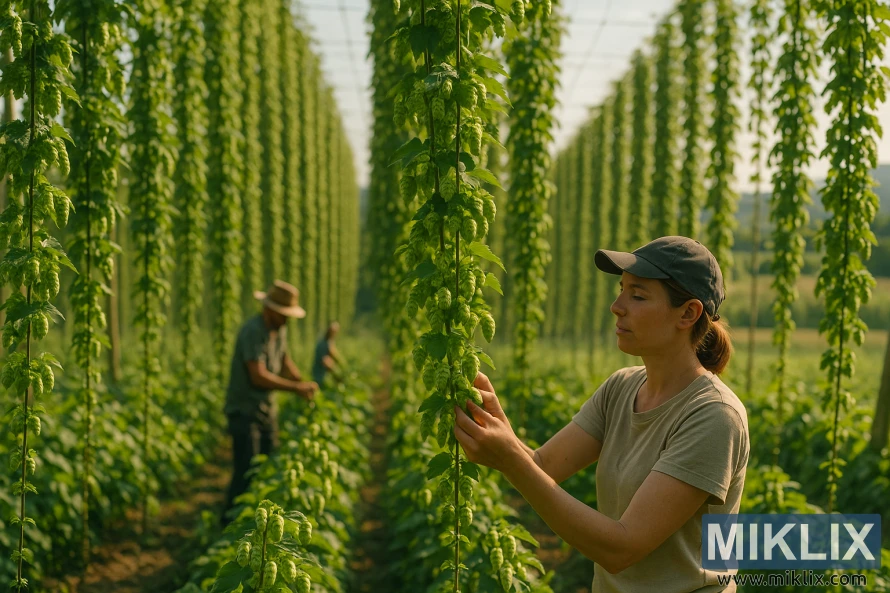
Flavor and Aroma Characteristics
Perle hops bring a unique blend of spice, pepper, and floral notes to beer styles. Their flavor and aroma profile is mild to moderate, fitting a broad spectrum of brewing needs.
Perle hops are prized for their balanced impact on beer's flavor and aroma. They add subtle notes that enrich the beer's character without dominating it. The spice and pepper elements stand out, adding depth to the beer's taste.
The aroma of Perle hops is equally complex, with floral notes complementing the spicy and peppery aspects. This balance makes them a top pick for brewers aiming to craft beers with a rich, layered aroma.
- Mild to moderate flavor intensity
- Notes of spice and pepper
- Floral elements in the aroma
In brewing, Perle hops' versatility shines through in their ability to enhance beer's flavor and aroma. By using Perle hops, brewers can create balanced beers that cater to diverse tastes.
Best Beer Styles for Perle Hops
Perle hops are versatile, fitting into a variety of beer styles. They work well in sessionable ales and German-inspired lagers. Their balanced flavor and aroma enhance brewing recipes without dominating them.
They're perfect for traditional German beers like Kölsch and Munich Helles. These beers need a subtle hop flavor that complements the malt. Perle hops also excel in pale ales, lagers, and wheat beers. They offer brewers a flexible ingredient for their craft brewing projects.
- Sessionable ales
- German-inspired lagers
- Wheat beers
- Pale ales
- Kölsch
- Munich Helles
When using Perle hops, think about the beer's overall character. They add a unique flavor and aroma to your brews. By adding Perle hops, you can craft a variety of beers that highlight their distinct qualities.
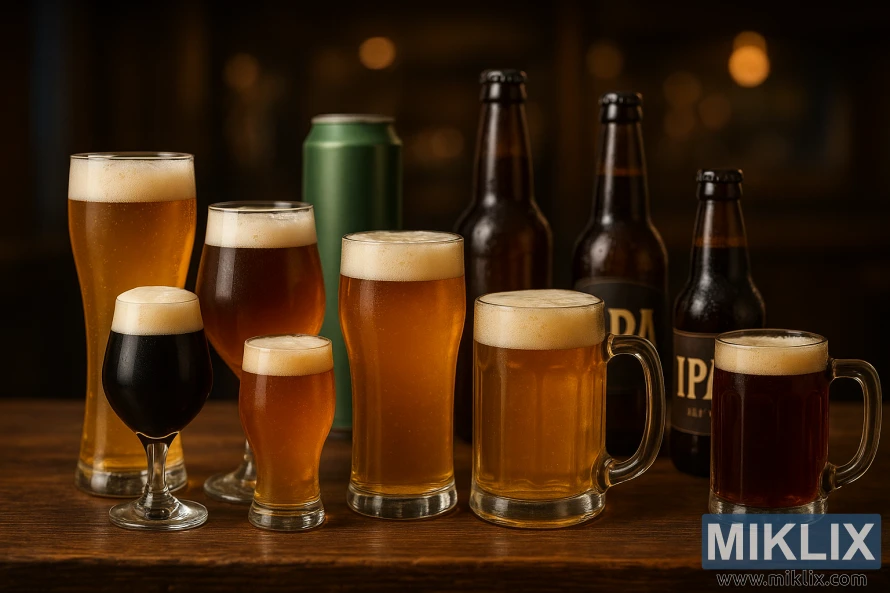
Bittering Applications in Brewing
Perle hops are perfect for achieving a balanced bitterness in beer, thanks to their moderate alpha acid content. This makes them a favorite among brewers who seek a clean and crisp taste in their brews.
The bittering ability of Perle hops is key in beer brewing. They offer a neutral background, allowing other aroma hops to take center stage. This is great for beers that need a subtle hop flavor.
Using Perle hops for bittering brings several benefits. These include:
- A balanced bitterness that complements the beer's flavor profile
- A clean and neutral background for other hop varieties
- Flexibility in brewing various beer styles
Perle hops are versatile in bittering applications, fitting well in many beer styles. Their alpha acid content, usually between 7-10%, works well with both traditional and modern brewing methods.
To get the most out of Perle hops, brewers need to consider a few factors. These include boil time, hop quantity, and the wort's specific gravity. Adjusting these can help brewers achieve the perfect bitterness and a well-balanced beer.
Aroma and Late Addition Uses
Perle hops are not just for bittering; they also bring a distinct aroma and flavor profile to the brewing process. When used in late additions or for dry hopping, Perle hops can significantly enhance the aromatic characteristics of beer.
Late addition uses of Perle hops involve adding them towards the end of the boil, typically within the last 15 minutes. This technique helps preserve the delicate aromatic compounds that might be boiled off. The result is a more complex and nuanced aroma that complements the beer's overall flavor profile.
Dry hopping with Perle hops is another technique brewers use to maximize aroma. By adding hops to the fermentation tank or directly to the beer after fermentation, brewers can infuse the beer with a fresh, hoppy aroma. Perle hops are well-suited for this application due to their floral and spicy notes.
- Best practices for using Perle hops in late additions include maintaining a consistent temperature and ensuring proper sanitation to prevent contamination.
- For dry hopping, the ratio of hops to beer volume is critical, and brewers should experiment to find the optimal balance for their specific beer style.
- The timing of dry hopping can also impact the final aroma, with longer contact times generally resulting in a more pronounced hop character.
By incorporating Perle hops into their late addition and dry hopping strategies, brewers can create beers with rich, complex aromas that enhance the drinking experience.
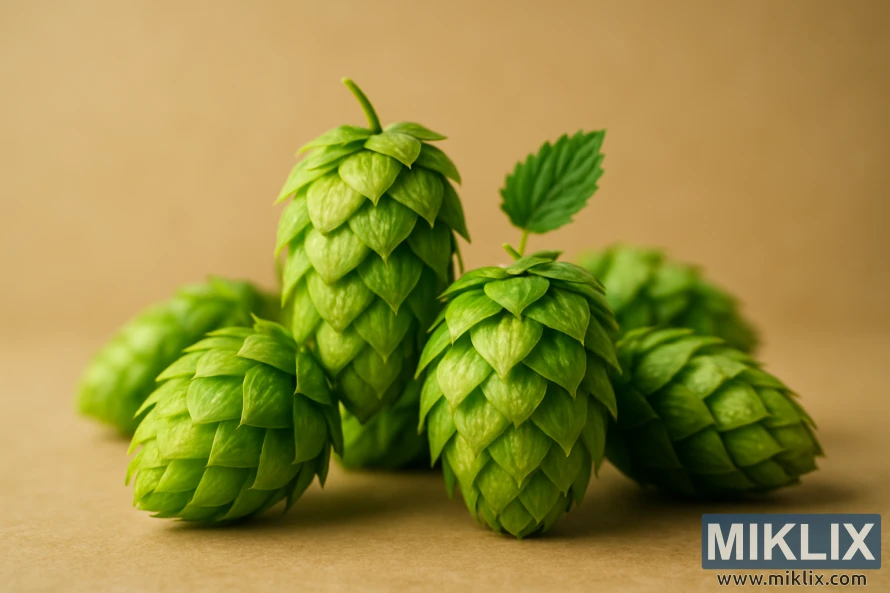
Dry Hopping with Perle
Consider using Perle hops for dry hopping to enhance your beer's depth and nuance. Dry hopping involves adding hops to the beer post-fermentation. This allows the hops to infuse their flavor and aroma into the beer.
Perle hops are ideal for dry hopping due to their delicate and complex flavor profile. They can add a subtle yet distinctive character to the beer. This enhances the overall flavor and aroma of the brew.
- Use Perle hops in moderation to avoid overpowering the beer.
- Consider combining Perle hops with other hop varieties to create a unique flavor profile.
- Monitor the beer's flavor and aroma during the dry hopping process to achieve the desired outcome.
Dry hopping with Perle hops can result in a beer with a rich and complex flavor profile. It's an excellent choice for brewers aiming to add complexity to their beers.
Storage and Preservation Methods
Keeping Perle hops in top condition requires careful storage and preservation. Hops can lose quality over time due to heat, light, and oxygen. These factors can greatly affect their flavor and aroma.
To keep Perle hops' distinct qualities, brewers must use effective storage techniques. This means storing hops in a cool, dark place, ideally below 40°F (4°C). This slows down the degradation process.
- Store hops in airtight containers or packaging to prevent exposure to oxygen.
- Keep hops away from direct light, as UV rays can cause hop oils to degrade.
- Maintain a consistent refrigerated temperature to preserve hop potency.
- Minimize the frequency of opening hop containers to reduce exposure to air.
By adhering to these storage and preservation methods, brewers can ensure their Perle hops maintain their unique flavor and aroma. This is essential for producing high-quality beers.
Common Brewing Mistakes to Avoid
Even with the versatility of Perle hops, brewers can fall into common pitfalls. These mistakes can affect the beer's flavor, aroma, and quality. It's essential to avoid these to get the best results with Perle hops.
One common mistake is using the wrong amount of hops. Too little, and the beer might lack bitterness or aroma. Too much, and it could become overpowering. To avoid this, measure your hops carefully and adjust according to your recipe and style.
- Insufficient brewing time, leading to under-extracted or over-extracted flavors.
- Poor fermentation conditions, such as incorrect temperatures or inadequate yeast pitching rates.
- Inadequate dry hopping techniques, resulting in lost aroma and flavor.
To minimize these risks, brewers should plan and monitor their brewing process carefully. This includes maintaining proper sanitation, using quality ingredients, and following proven practices. By avoiding these common mistakes, brewers can ensure their beer showcases Perle hops' best qualities.
By being mindful of these pitfalls and taking steps to avoid them, brewers can consistently produce high-quality beers. These beers will meet their expectations and those of their customers.
Alternative Hop Combinations
Perle hops offer brewers a chance to explore various hop combinations. This experimentation leads to unique and complex flavors in their beers.
When paired with different hop types, Perle hops can create distinct characteristics. For instance, combining Perle with citrusy hops like Cascade or Centennial adds a bright, citrusy note. This enhances the beer's flavor and aroma.
Conversely, pairing Perle with earthy or herbal hops like Fuggles or East Kent Goldings deepens the beer's complexity. The success of hop combinations hinges on understanding how different varieties complement or contrast with Perle's traits.
- Combining Perle with spicy hops like Saaz or Hallertau introduces a subtle spice flavor.
- Pairing Perle with floral hops like Willamette or Mount Hood adds a delicate floral note.
- Using Perle with bitter hops like Chinook or Warrior increases the beer's bitterness.
Through hop combination experimentation, brewers can craft a vast array of beer flavors and styles. This ranges from crisp, refreshing lagers to complex, hoppy ales.
Commercial Examples and Success Stories
Commercial beers featuring Perle hops showcase the hop's unique traits and brewing possibilities. Perle hops are used across various beer styles, from lagers to ales. This versatility highlights their role in craft brewing.
Several notable breweries have successfully incorporated Perle hops into their recipes. Some use them as a bittering agent due to their high alpha acid content. Others appreciate their subtle aroma contributions.
Examples of commercial beers that use Perle hops include traditional German lagers and American pale ales. These beers demonstrate Perle hops' adaptability in different brewing traditions.
- Traditional German lagers benefit from the clean, mild flavor of Perle hops.
- American pale ales utilize Perle hops for their balanced bitterness and subtle aroma.
- Craft brewers appreciate Perle hops for their versatility in both bittering and aroma applications.
The success of these beers highlights the value of Perle hops in commercial brewing. They offer brewers a reliable and flavorful hop variety.
Conclusion
Perle hops have become a key ingredient in beer brewing, known for their balanced flavor and aroma. They offer a moderate alpha acid content, making them perfect for brewers aiming to craft complex beers. This versatility makes them a go-to choice for many brewers.
Perle hops can be used in a variety of beer styles, from bittering to dry hopping. This flexibility opens up a world of creative possibilities for brewers. As the craft beer industry grows, the need for premium ingredients like Perle hops will continue to drive the creation of outstanding beers.
By mastering the use of Perle hops, brewers can introduce new flavors and aromas to their beers. This can elevate their craft beer to new levels. Whether you're a seasoned brewer or just starting, using Perle hops can be a rewarding experience. It allows you to explore new recipes and techniques, pushing the boundaries of your brewing skills.
Further Reading
If you enjoyed this post, you may also like these suggestions:
